Happy Valentine's Day to you!
Are you tired of swiping left and right on dating apps, going on countless first dates, and still not finding that special someone? Have you ever wondered if something as simple (yet, complex) as your DNA could influence your search for love? In this article, we dive into the growing field of genetic matchmaking and explore whether our genes can influence love. Get ready to learn about the science behind attraction and the potential benefits and drawbacks of using DNA to find your perfect match.
When we say “attraction,” it often involves the “reward pathway system” of our brains.
This refers to how pleasurable we feel upon doing a particular activity or how rewarding the activity is.
The primary hormone that gives the “rewarding feeling” is dopamine, produced in the hypothalamus.
It is released when we do things that feel good/pleasurable to us. This can include spending time with loved ones or having sex.
When we are attracted to someone, the high levels of dopamine trigger the release of another hormone, norepinephrine, making us feel giddy, energetic, and euphoric.
This partly explains why the first few weeks of dating can be exciting, thrilling, and consuming!
According to research studies, brain scans of people “in love” have shown that the reward centers light up like crazy when shown photos of people they are attracted to.
The role of genetics in influencing compatibility between two people cannot be overlooked.
Specific genes are crucial to predicting the potential for a satisfying sexual experience and a successful marriage.
Other genes influence the traits we seek in a partner.
Studies have shown that specific genes, such as the DRD4 gene, can impact our preferences for certain personality traits in a romantic partner.
For example, individuals with a particular change in the DRD4 gene are more likely to be attracted to adventurous and spontaneous partners.
Similarly, some genes have been linked to our sense of smell and how it influences our attraction to potential partners.
Personality traits significantly influence who we are attracted to and who we form relationships with.
While these traits are shaped by a combination of lifestyle and environmental factors, recent research has shown that there is a genetic component to personality.
Studies have identified specific genes linked to traits such as extraversion, openness, and neuroticism.
For example, the 5-HTTLPR gene has been linked to levels of neuroticism, with specific changes in the gene being associated with higher levels of anxiety and stress.
When it comes to dating, our personality traits can have a significant impact on our preferences for potential partners.
Extroverted individuals may be more likely to be attracted to other extroverted individuals.
On the other hand, those who are more neurotic may prefer more stable and calming partners.
DNA dating, also known as genetic matchmaking, is a new approach to finding romantic partners based on genetic compatibility.
The idea is that analyzing a person's DNA makes it possible to identify genetic markers associated with compatibility in relationships regarding personality, sexual chemistry, and other essential factors.
This information can then be used to match individuals with partners who are more likely to complement these traits.
DNA dating typically involves taking a DNA sample through a simple cheek swab or saliva sample.
This sample is then analyzed in a laboratory to identify specific genetic markers associated with compatibility.
The results of this analysis are then compared with a database of other individuals who have also had their DNA analyzed to find potential matches.
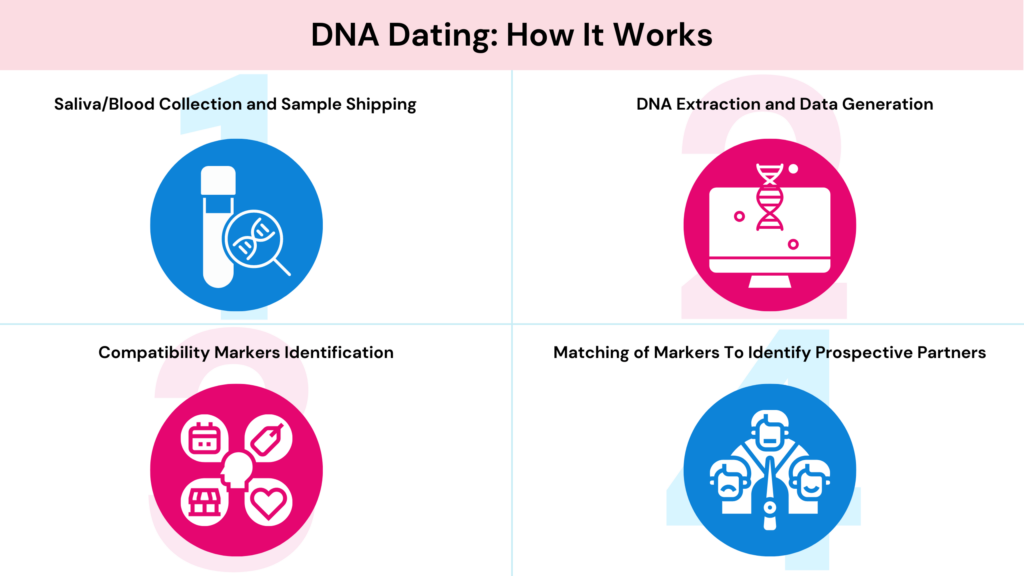
The success of DNA dating is a subject of debate in the scientific community.
Some proponents of DNA dating argue that it offers a more scientific and objective approach to matchmaking than traditional methods such as online dating and matchmaking services.
They argue that analyzing specific genetic markers makes it possible to gain a deeper understanding of a person's personality and preferences, leading to more compatible and successful relationships.
On the other hand, many experts have raised several concerns about DNA matchmaking.
One issue is the lack of robust scientific evidence to support its claims of more excellent compatibility and success in relationships.
While some genetic markers have been linked to specific personality traits, the relationships between genetics and compatibility are poorly understood.
Furthermore, there is limited research on the long-term outcomes of relationships formed through DNA dating, making it difficult to evaluate its effectiveness.
It is important to note that while genetics shape our personality traits and attractions, they are not the sole determining factor.
Environmental factors such as upbringing and life experiences also significantly influence who we are attracted to and why.
Therefore, it is vital to approach DNA dating cautiously and view it as just one tool in the matchmaking process rather than the sole determinant of compatibility.
DNA matching for love may be a promising concept, but it is still uncertain whether it is possible or practical.
Further research is needed to fully understand the connection between genetics and compatibility and determine the feasibility of using DNA to match individuals for love.
The idea of dating and DNA is a fascinating concept that raises many questions about the role of genetics in our romantic lives.
While our genes may influence certain personality traits, it's important to remember that they do not dictate who we fall in love with.
Love is a complex and multi-faceted emotion influenced by many factors, including our environment, experiences, and personal preferences.
Ultimately, while our genes may shape who we are and how we behave, they do not determine our fate.
The beauty of love is that it allows us to choose our paths and create our destinies.
So, whether you believe in the power of DNA or not, remember that at the end of the day, it's up to you to make your own choices and forge relationships.
Are psychopaths born or made? Despite decades of research, the origins of psychopathy remain elusive, with some experts attributing the condition to a complex interplay of genetic, environmental, and neurobiological factors. In this article, we delve into the latest research on the genetic basis of psychopathy and examine the evidence for and against a genetic cause.
“Psychopath” is a term used to describe a person who consistently exhibits callous and unemotional traits.
A lack of empathy, impulsiveness, antisocial skills, manipulation, abnormal emotional response, and violence all fall under “callous and unemotional traits.”
However, it is important to note here that psychopathy is not an official mental health diagnosis. Several traits seen in psychopathy also occur in antisocial personality disorder or sociopathy.
There is no single known cause for psychopathy. But several factors have been documented to play a role:
Research suggests that psychopathy tends to run in families.
The “callous and unemotional” traits seen in psychopathy have moderate to strong heritability, according to studies.
Expert opinion
Dr. Igor Galynker, an American psychiatrist, clinician, and researcher, says that 60-70% of psychopathy is genetic.
He further adds that this has been confirmed by adoption studies that examined identical twins who were separated at birth and raised in different families.
According to a 2011 study done on adoptees, having a criminal biological father was associated with higher psychopathic personality traits in males.
In fact, it increased the odds of the adoptees ranking in the top 10% of the psychopathy scale by 8.5 times!
Since adoptees don’t grow up with their biological parents, this displays an undeniable genetic influence on psychopathic traits.
However, there’s no single “psychopathy” gene.
Rather, the effects of several gene changes combined with certain environmental or lifestyle factors can result in psychopathy.
Some genes implicated in psychopathy are:
Most of these genes are involved in the breakdown of brain chemicals like dopamine and serotonin.
Any variants or changes in these genes can result in an imbalance in brain chemicals and may lead to abnormal behaviors.
Of these genes, MAOA is of particular interest.
This gene gives instructions for the production of the monoamine oxidase enzyme.
The MAOA enzyme breaks down brain chemicals like dopamine, serotonin, epinephrine, and noradrenaline.
Individuals with a particular variant of this gene - the MAOA-L, may produce lower quantities of the enzyme.
As a result, there may be an excess build-up of these signaling chemicals in the brain, leading to different impulsive behaviors.
In fact, in 2009, an Italian court reduced the sentence of a convicted murderer by one year, accepting the claim that he had a genetic version of the MAOA gene that encouraged aggressive behavior.
Will everyone with this variant of the MAOA-L gene show psychopathic traits?
Not necessarily!
This version of the MAOA gene only increases the likelihood of exhibiting psychopathic traits with specific environmental triggers.
In short, genetics plays a big role in the development of psychopathy by influencing brain structure and brain chemical levels. The inheritance of psychopathic traits is more pronounced in males than females.
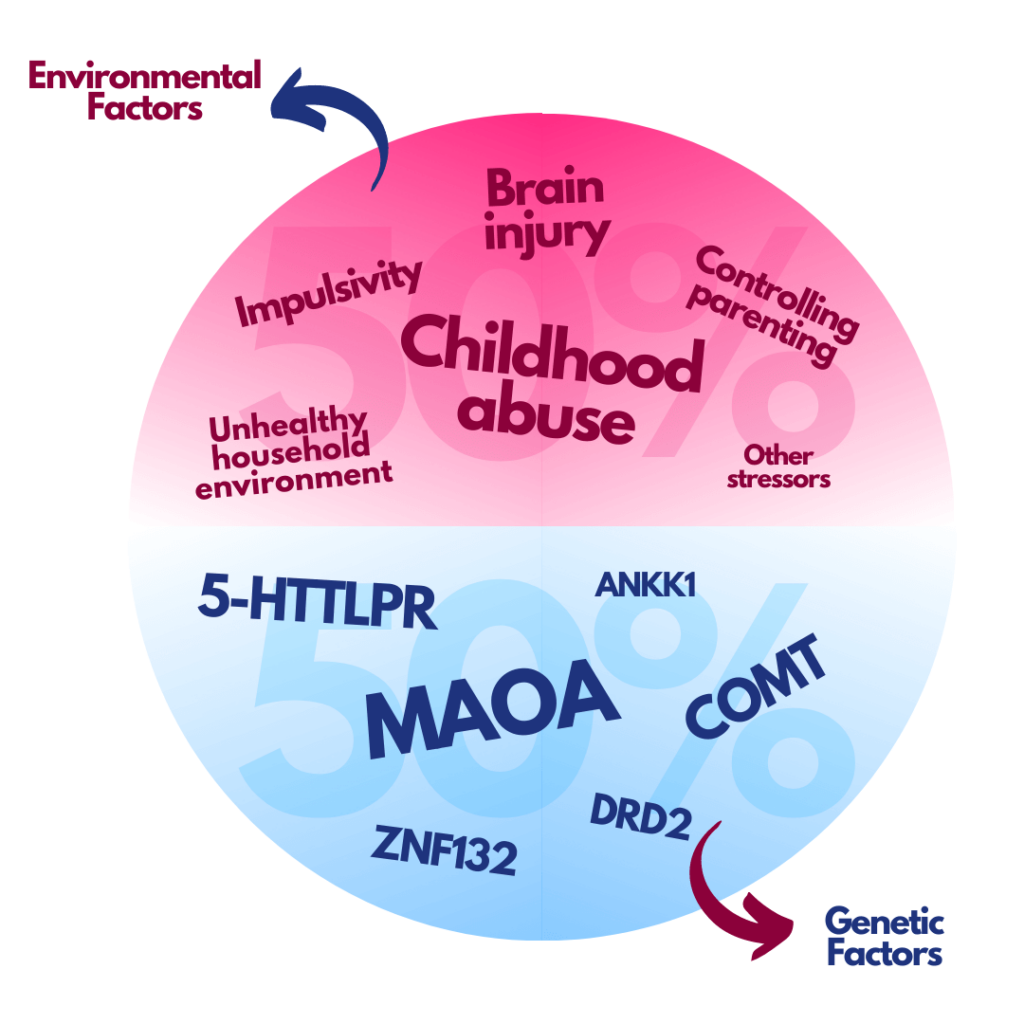
Many environmental factors play a role in the risk of psychopathy.
Some of them include:
The brains of people with psychopathy show structural and functional differences in certain brain regions.
The PFC, located on the frontal lobe, is responsible for cognitive functions, while the amygdala regulates emotions.
Studies show that those with psychopathy exhibit reduced connections between these two brain regions as well as lower gray matter volume in both regions.
A review study that looked at neuroimaging in people with psychopathy reported a reduced gray matter volume in the hippocampal region.
The hippocampus is responsible for memory, learning, and emotional processing.

Identifying gene variants associated with psychopathy can help with early intervention in terms of providing the right environment or therapeutic support.
However, researchers have identified only a handful of genetic variants associated with psychopathy.
More genes could play equally important roles in causing the condition, which are yet to be discovered.
Future research on psychopathy will focus more on epigenetics and try to understand precise interactions between genes and the environment.
Such an understanding can help reduce the risk of individuals developing psychopathic traits.
Specific gene variants can increase one’s risk of developing psychopathy, and one can inherit these genes from the parents.
However, environmental factors like prenatal exposure, parenting techniques, neighborhood, and childhood can influence psychopathic traits equally.
Therefore, both genes and environment are interrelated and are equally important in determining whether or not a person grows to develop antisocial behaviors, including psychopathy.

How Does Anxiety Affect Your Brain?

The Gut-Brain Connection: Probiotics For Depression

Genetic Testing For Mental Health
When should you work out to reduce weight? The debate over the best time of day to exercise for fat loss has been going on for years. Some people swear by working out in the morning, while others prefer to hit the gym after work. So which is better? In this article, we'll take a closer look at the science behind exercising in the morning or evening and help you decide which approach is best for you.
How much weight you lose with exercise is greatly influenced by your genes! Learn more:
Before exploring the benefits of morning vs. evening workouts, we need to get one thing out of the way - the best time to exercise is whenever you can.
Not all of us may have a flexible schedule allowing us to do a 90-minute power-packed workout session, followed by a visit to the juice bar for a dose of green smoothie.
If you can get in a 20-minute workout mid-morning, doing it consistently will yield better results than forcing yourself to wake up at 5 AM and work out (only to miss it 4 out of 7 days).
Nevertheless, morning and evening workouts both have their advantages and disadvantages.
Advantages
Disadvantages
Advantages
Disadvantages
Research has shown that both morning and evening workouts can effectively lose weight.
However, the optimal time of day for exercise may depend on individual factors such as circadian rhythms and personal preferences.
It's important to remember that consistency and frequency of exercise are key for weight loss, regardless of the time of day.
A new study from Karolinska Institutet in Sweden and the University of Copenhagen in Denmark examined the relationship between exercise time and fat loss in mice.
The results are published in the journal PNAS.
The researchers subjected the 10- to 11-wk-old mice to a 1-hour session of high-intensity exercise twice daily - late morning (early active phase) and late evening (early rest phase).
They then studied the mice's adipose (fat) tissue to check the markers for fat metabolism and analyze the activities of the genes involved in fat burning.
Some of the fat metabolism markers examined were:
The study observations were as follows:
Even though mice and humans share many physiological functions, it is essential to consider that mice are nocturnal.
More studies are needed to draw reliable conclusions about the relevance of our findings to humans.
If you're not a morning person, waking up early to exercise can seem daunting.
However, with a few strategies and some persistence, it's possible to become a morning workout person and stick with it.
Here are some tips to help you get started:
Becoming a morning workout person and sticking with it requires planning, persistence, and patience.
With time and consistency, you may find that waking up early to exercise becomes easier and more enjoyable.
Are you often troubled by morning headaches and daytime sleepiness? This can point to an underlying sleep order, specifically obstructive sleep apnea. This condition is heritable, and studies have identified genetic factors that directly and indirectly contribute to this condition.
Obstructive sleep apnea (OSA) is a sleep disorder characterized by recurrent episodes of breathing cessation (breathing stops and starts) during sleep.
These episodes, called apneas, are caused by a partial or complete airway blockage.
This leads to a decrease in oxygen levels and an increase in carbon dioxide levels, which can cause the brain to wake the person briefly to open the airway.
This can happen several times per hour and disrupts the normal sleep pattern, leading to daytime fatigue and other symptoms.

OSA can have a significant impact on an individual's health.
The recurrent episodes of breathing cessation during OSA can lead to a decrease in oxygen levels, which can cause damage to the brain and other vital organs if left untreated for a long time.
Additionally, OSA can lead to high blood pressure, heart disease, stroke, and type 2 diabetes.
OSA can also cause or worsen symptoms of depression and anxiety, leading to poor quality of life due to daytime fatigue, difficulty concentrating, and irritability.
Additionally, it can affect the ability to drive and work, leading to decreased productivity and increased risk of accidents.
Therefore, diagnosing and treating OSA is essential to prevent these adverse health effects.
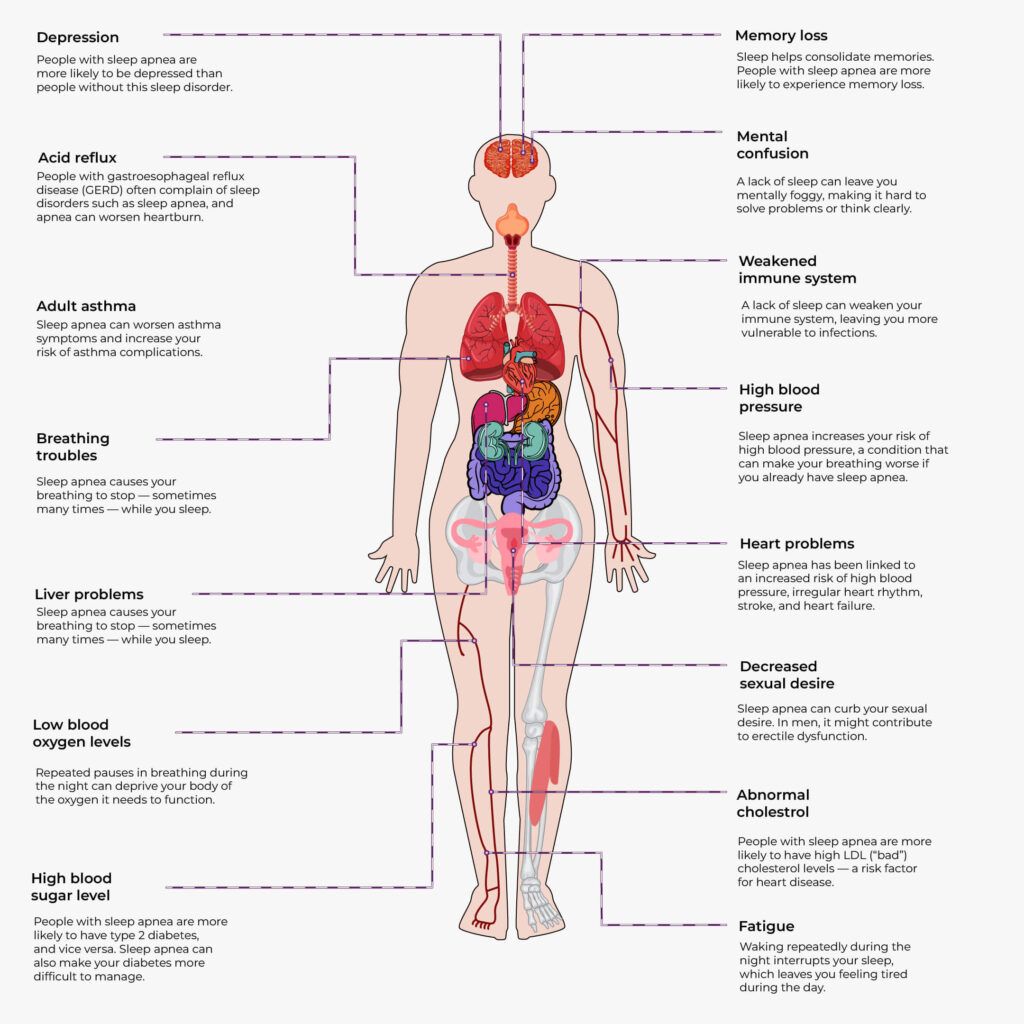
Researchers have identified genetic factors contributing to a person’s risk of developing OSA.
People with a family history of OSA are at greater risk of developing the condition.
Genes associated with OSA are involved in many body processes like
Other than your genes, several factors increase the risk for OSA.
Curious about your obstructive sleep apnea genes? Here’s how you can learn about it in 3 simple steps:
Asthma is the most common chronic childhood disease in developed nations. The number of people with asthma has increased in the world over the last 25 years. Asthma can be genetic, though not all cases of asthma are inherited.
Asthma is a condition that affects the lungs.
It occurs when the immune system gives an exaggerated response to environmental triggers, resulting in inflammation and increased mucus production inside the nasal passage.
This can also tighten the muscles around the airways, making it difficult to breathe.
Most asthma cases are diagnosed in childhood.
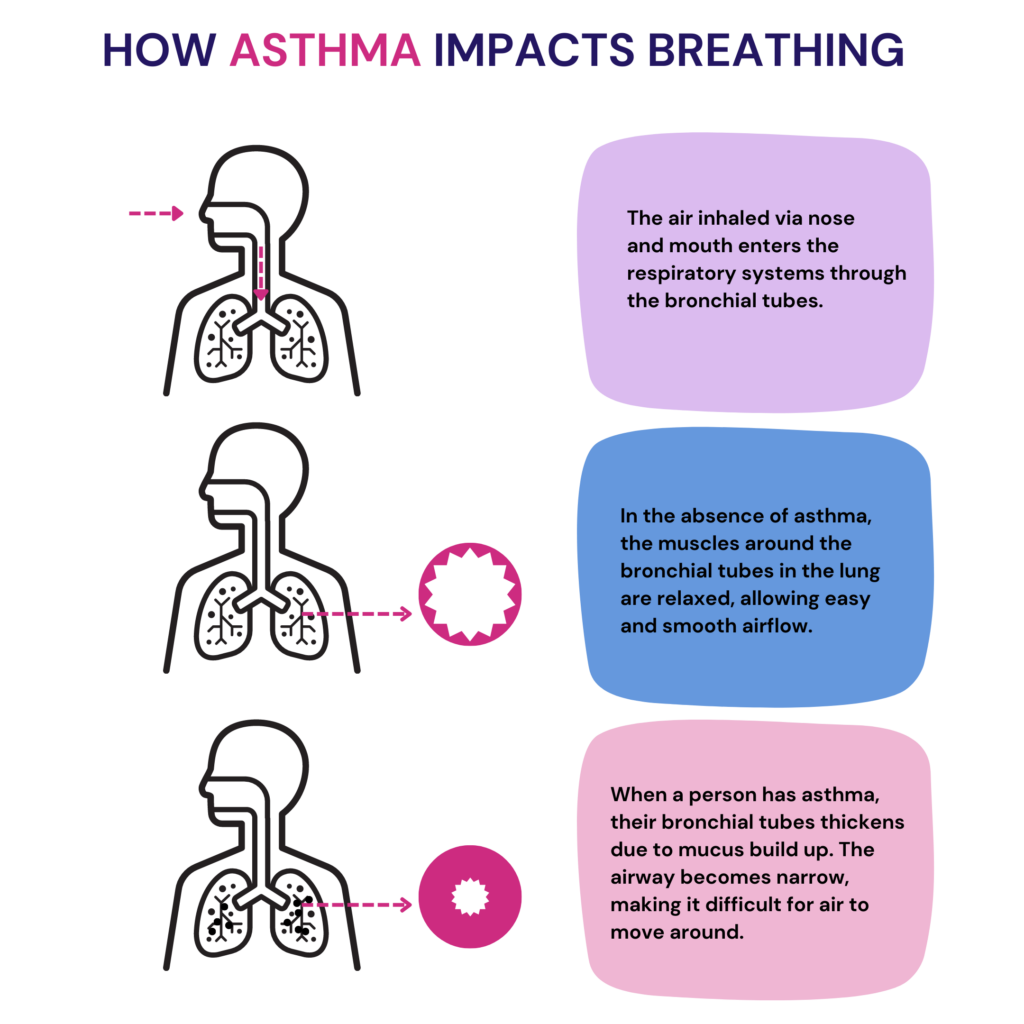
Asthma symptoms come and go, and certain triggers can cause flare-ups.
The main symptoms include wheezing, coughing, chest tightness, and shortness of breath.
Long-term exposure to asthma symptoms can also lead to decreased lung function and an increased risk of other respiratory infections.
Asthma can also affect a person's mental health.
People with asthma may experience anxiety and depression due to the fear of having an asthma attack or due to the limitations imposed by the condition.

The risk of asthma for a child increases when either or both parents have asthma. This suggests a genetic link.
But no single gene causes asthma. It is the impact of many genetic changes that influences the risk of asthma for a person.
The individual impact of each variant may be only small, but when considered together, it can increase asthma risk considerably.
So far, research has identified various gene complexes that may play a significant role in the development of asthma. These include DPP1, GRPA, and SPINK5 genes.
But keep in mind that genetics is only part of the story.
Certain health conditions like certain allergies, eczema, and obesity increase the risk for asthma.
People from certain ethnicities, like African Americans, Puerto Rican, and Indigenous Americans, are more likely to experience asthma.
Curious about your asthma genes? Here’s how you can learn about it in 3 simple steps:
Are you one of the millions searching for answers to the persistent redness, bumps, and pimples on your face? The search for the cause of rosacea may lead you down a genetic path, as new research suggests a strong connection between this chronic skin condition and our DNA.
Rosacea is a chronic skin condition that causes redness, inflammation, and pimple-like bumps on the face.
It is most commonly found on the cheeks, nose, chin, and forehead.
The cause of rosacea is not well understood, but it is thought to be related to factors such as genetics, the immune system, and blood vessel abnormalities.
The condition can be managed with lifestyle changes and medical treatment, but there is no cure.
Rosacea is a skin condition, but it can also affect a person's mental health.
Some people with rosacea may experience low self-esteem, anxiety, and depression due to the redness and visible symptoms on their faces.
In severe cases, rosacea can also lead to eye problems such as conjunctivitis and corneal damage, so prompt diagnosis and treatment are important.
It's also important to note that while rosacea is not life-threatening, it is a chronic condition that requires ongoing management to prevent the worsening of symptoms.
Studies have shown that there is a higher incidence of rosacea in people with a family history of the condition.
This suggests that there may be a genetic component to rosacea.
Several genes have been associated with rosacea, but the exact genes that cause the condition are poorly understood.
Many studies have identified genetic variations that are more common in people with rosacea than those without the condition.
Some of these genes are involved in the immune system and inflammation, while others are involved in the regulation of blood vessels and skin structure.
However, more research is needed to understand the genetic factors underlying rosacea fully.
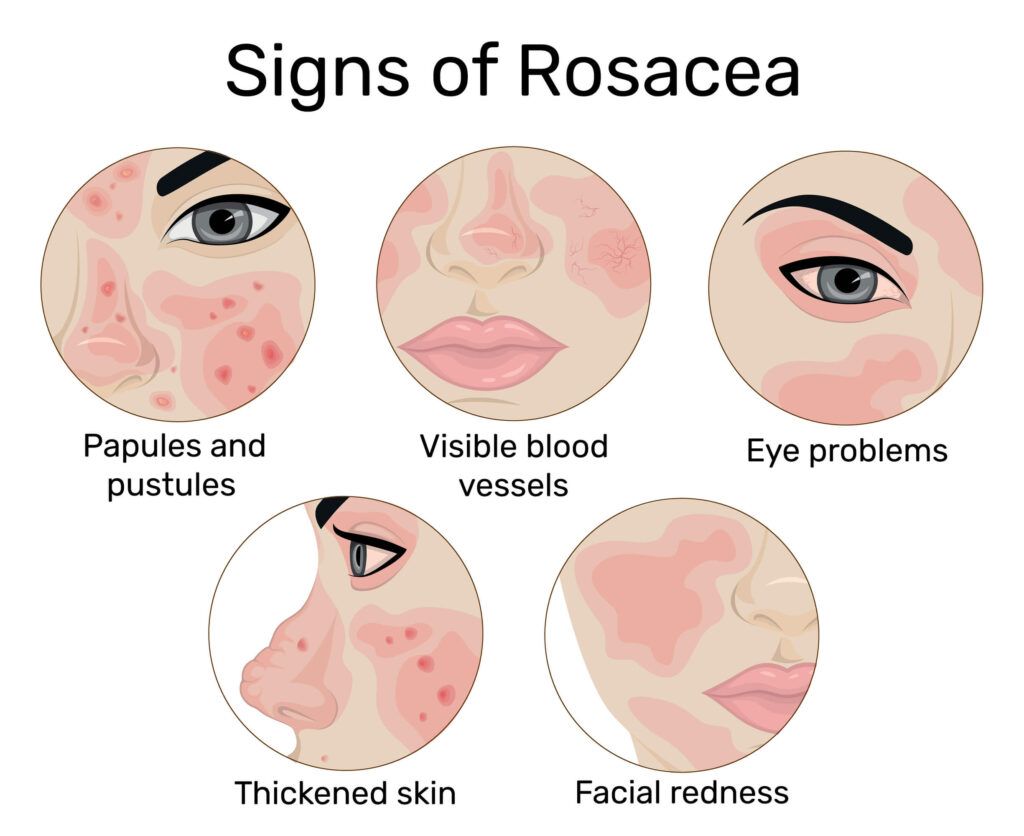
Several factors may increase a person's risk of developing rosacea, including:
It's important to note that not everyone with these risk factors will develop rosacea, and having none of them does not guarantee that a person will not develop the condition.
Further research is needed to fully understand the underlying causes of rosacea and the role of these risk factors.
Curious about your anxiety genes? Here’s how you can learn about it in 3 simple steps: